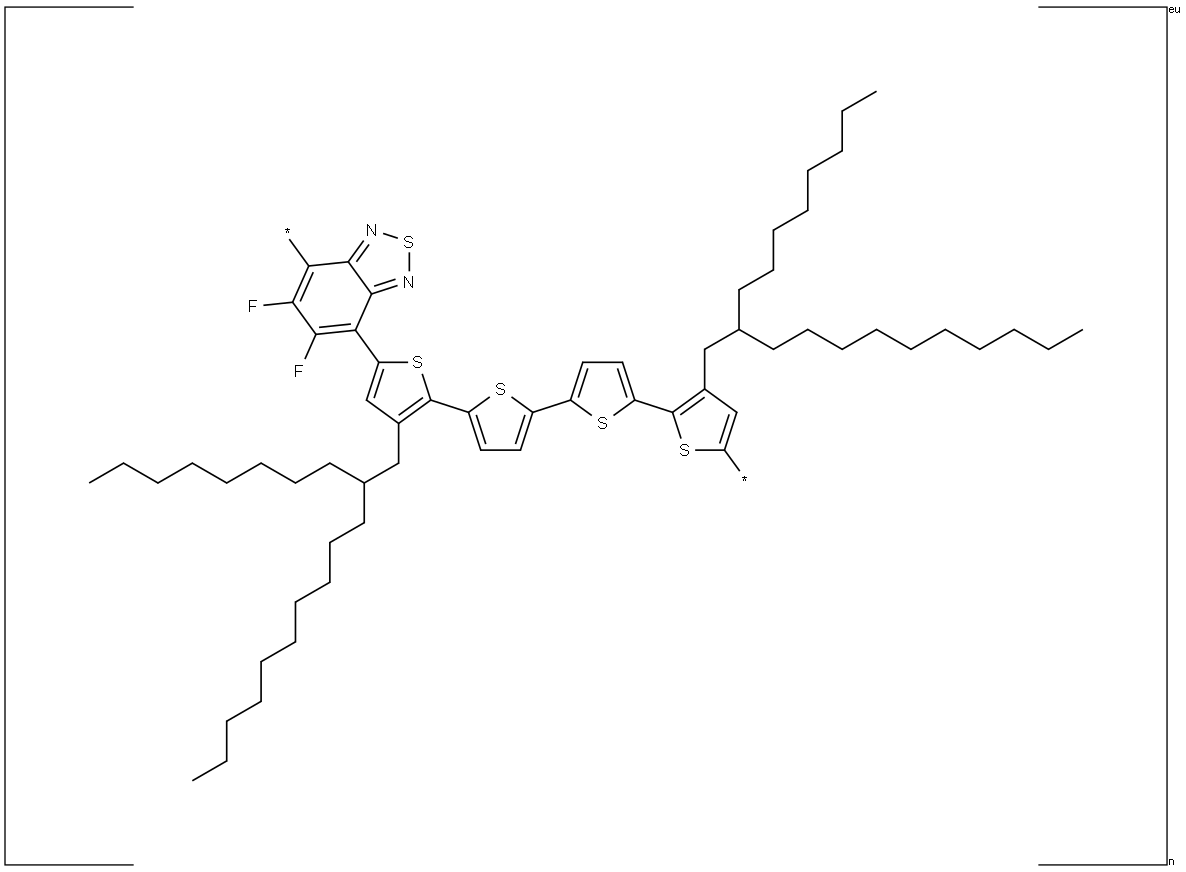PffBT4T-2OD (PCE11) is a low band-gap (1.65 eV) semiconducting polymer for organic photovoltaics (OPVs), which has reached power conversion efficiencies (PCEs) approaching 11% [1]. These efficiencies are a result of the high crystallinity of the polymer, providing excellent hole transport mobilities on the order of 10-2 cm2V-1s-1, and the ability to use a thick active layer, resulting in improved light absorption.
The size and position of the alkyl chains of PffBT4T-2OD are critical to its temperature dependant aggregation properties, enabling control over the aggregation and crystallisation of the polymer to produce an efficient donor:acceptor film morphology.
Polymer PCE11 was targeted by reacting 4,7-bis(5-bromo-4-(2-octyldodecyl)thiophen-2-yl)-5,6-difluorobenzo[c][1,2,5]-thiadiazole with 2,5-bis(trimethylstannyl)thieno[3,2-b]thiophene engaging Stille Coupling reaction.
![PCE11 (PffBT4T-2OD) synthesis with 4,7-bis(5-bromo-4-(2-octyldodecyl)thiophen-2-yl)-5,6-difluorobenzo[c][1,2,5]-thiadiazole with 2,5-bis(trimethylstannyl)thieno[3,2-b]thiophene as starting materials engaging Stille Coupling reaction PCE11 (PffBT4T-2OD) synthesis with 4,7-bis(5-bromo-4-(2-octyldodecyl)thiophen-2-yl)-5,6-difluorobenzo[c][1,2,5]-thiadiazole with 2,5-bis(trimethylstannyl)thieno[3,2-b]thiophene as starting materials engaging Stille Coupling reaction](/NewsImg/2018-01-16/20181161652569674.jpg) PCE11 (PffBT4T-2OD) synthesis with 4,7-bis(5-bromo-4-(2-octyldodecyl)thiophen-2-yl)-5,6-difluorobenzo[c][1,2,5]-thiadiazole with 2,5-bis(trimethylstannyl)thieno[3,2-b]thiophene as starting materials engaging Stille Coupling reaction.
PCE11 (PffBT4T-2OD) synthesis with 4,7-bis(5-bromo-4-(2-octyldodecyl)thiophen-2-yl)-5,6-difluorobenzo[c][1,2,5]-thiadiazole with 2,5-bis(trimethylstannyl)thieno[3,2-b]thiophene as starting materials engaging Stille Coupling reaction.
![PCE11 (PffBT4T-2OD) synthesis with 4,7-bis(5-bromo-4-(2-octyldodecyl)thiophen-2-yl)-5,6-difluorobenzo[c][1,2,5]-thiadiazole with 2,5-bis(trimethylstannyl)thieno[3,2-b]thiophene as starting materials engaging Stille Coupling reaction PCE11 (PffBT4T-2OD) synthesis with 4,7-bis(5-bromo-4-(2-octyldodecyl)thiophen-2-yl)-5,6-difluorobenzo[c][1,2,5]-thiadiazole with 2,5-bis(trimethylstannyl)thieno[3,2-b]thiophene as starting materials engaging Stille Coupling reaction](/NewsImg/2018-01-16/20181161652569674.jpg)